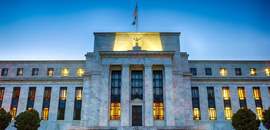A fundamental precept of investing is that to make a sound decision one must first understand what news is priced into markets.
This caveat is particularly relevant today as investors grabble with a nearly 40 basis point drop in Treasury bond yields in the past month. This is perplexing considering that CPI inflation in June surged to 5.4% and 4.5% excluding food and energy.
Amid this, two competing explanations have been put forth. It is important to understand them because they have different implications for financial markets.
The Federal Reserve’s view, which is shared by many investors, is that the spike in inflation will be temporary. Fed officials contend that supply-demand imbalances linked to the COVID-19 pandemic have created temporary shortages of certain items such as raw materials and computer chips that impact prices of homes, new and used cars, and many manufactured goods. Excluding such items, the trimmed mean rate of inflation calculated by the Federal Reserve of Dallas is closer to the Fed’s target of 2 percent.
Earlier this year, some investors worried that the Fed would be slow to tighten monetary policy when it signaled the first rate hikes could be delayed until 2024. However, these concerns have lessened since the FOMC meeting in mid-June for two reasons. First, recent statements by Fed officials indicate they are more open minded that inflation readings could stay elevated for a while. Second, the “dots” that show projections for the federal funds rate suggest the Fed could tighten monetary policy by 2023.
Roberto Perli and Benson Durham of Cornerstone Macro (July 23) observe that investors’ inflation expectations have ratcheted down (see chart) since the meeting while the Treasury yield curve has flattened. They suggest bondholders are more confident now that the Fed will act to keep inflation under control. If so, bond yields could stay anchored around current levels, which would bode well for the stock market.
This caveat is particularly relevant today as investors grabble with a nearly 40 basis point drop in Treasury bond yields in the past month. This is perplexing considering that CPI inflation in June surged to 5.4% and 4.5% excluding food and energy.
Amid this, two competing explanations have been put forth. It is important to understand them because they have different implications for financial markets.
The Federal Reserve’s view, which is shared by many investors, is that the spike in inflation will be temporary. Fed officials contend that supply-demand imbalances linked to the COVID-19 pandemic have created temporary shortages of certain items such as raw materials and computer chips that impact prices of homes, new and used cars, and many manufactured goods. Excluding such items, the trimmed mean rate of inflation calculated by the Federal Reserve of Dallas is closer to the Fed’s target of 2 percent.
Earlier this year, some investors worried that the Fed would be slow to tighten monetary policy when it signaled the first rate hikes could be delayed until 2024. However, these concerns have lessened since the FOMC meeting in mid-June for two reasons. First, recent statements by Fed officials indicate they are more open minded that inflation readings could stay elevated for a while. Second, the “dots” that show projections for the federal funds rate suggest the Fed could tighten monetary policy by 2023.
Roberto Perli and Benson Durham of Cornerstone Macro (July 23) observe that investors’ inflation expectations have ratcheted down (see chart) since the meeting while the Treasury yield curve has flattened. They suggest bondholders are more confident now that the Fed will act to keep inflation under control. If so, bond yields could stay anchored around current levels, which would bode well for the stock market.

The alternative explanation is the decline in yields mainly reflects investors lowering their expectations of future economic growth.
The consensus among forecasters polled by Bloomberg is that GDP growth reached a peak of about 9% annualized in the second quarter, and will average close to 7% this year and 4%-5% next year. However, some believe these forecasts are too optimistic, because federal transfer payments are winding down while the Delta variant is spreading. If this were to result in slower growth, the stock market rally could fade if earnings growth softened.
A variant of this explanation is that the rise in inflation is linked to shortfalls in aggregate supply rather than demand being too strong. Greg Ip of The Wall Street Journal argues that “The U.S. is now experiencing several supply shocks at once, collectively throwing up a roadblock to what should be a powerful post-pandemic recovery.” In his view, the main risk is the economy could experience stagflation, in which inflation stays elevated while the economy slows.
So, which of these explanations is the most likely?
My own take is the first one is consistent with the performance of financial markets thus far: Namely, investors still view growth prospects as favorable, but their concerns about inflation have lessened because they believe the recent spike is not temporary. If the decline in yields reflected a lowering of growth prospects, one would expect the stock market to soften, which has not happened.
Yet, this still begs several questions. First, what does the Fed mean by the word temporary? When Jerome Powell first discussed the possibility of a spike, he alluded to the base effects from prices being abnormally low one year ago. More recently, Powell and other officials have acknowledged that the effects of supply shortages could last longer—perhaps to the end of this year or beyond. In that case, there is a risk that inflation expectations could become entrenched the longer it takes for price increases to be contained.
Second, when will the Fed begin to tighten monetary policy and by how much? Currently, the bond market is pricing in the Fed beginning to raise the federal funds rate by early 2023 and following with several additional hikes that year. This prognosis is consistent with the views of FOMC officials.
My own assessment is the Fed will have to act sooner and more often than is priced into markets.
One reason is that real yields are abnormally low. While negative real interest rates were appropriate during a severe recession, it is harder to justify them now when the economy is experiencing a powerful recovery. Furthermore, there is a possibility that $3.5 trillion of government spending will be enacted over the next 10 years to expand social programs, education, healthcare, and climate change. This would be in addition to increased spending on public infrastructure and could put further upward pressure on real yields if it came to fruition.
Second, investors’ views about inflation could change as new information becomes available. With economic output now approaching its pre-pandemic level, wage and price pressures are likely to build if economic growth exceeds the economy’s potential rate. In this respect, the prospects for inflation will ultimately be influenced by economic policies once the effects of supply imbalances from the pandemic abate over time.
A version of this article was posted to Forbes.com on July 27, 2021.
The consensus among forecasters polled by Bloomberg is that GDP growth reached a peak of about 9% annualized in the second quarter, and will average close to 7% this year and 4%-5% next year. However, some believe these forecasts are too optimistic, because federal transfer payments are winding down while the Delta variant is spreading. If this were to result in slower growth, the stock market rally could fade if earnings growth softened.
A variant of this explanation is that the rise in inflation is linked to shortfalls in aggregate supply rather than demand being too strong. Greg Ip of The Wall Street Journal argues that “The U.S. is now experiencing several supply shocks at once, collectively throwing up a roadblock to what should be a powerful post-pandemic recovery.” In his view, the main risk is the economy could experience stagflation, in which inflation stays elevated while the economy slows.
So, which of these explanations is the most likely?
My own take is the first one is consistent with the performance of financial markets thus far: Namely, investors still view growth prospects as favorable, but their concerns about inflation have lessened because they believe the recent spike is not temporary. If the decline in yields reflected a lowering of growth prospects, one would expect the stock market to soften, which has not happened.
Yet, this still begs several questions. First, what does the Fed mean by the word temporary? When Jerome Powell first discussed the possibility of a spike, he alluded to the base effects from prices being abnormally low one year ago. More recently, Powell and other officials have acknowledged that the effects of supply shortages could last longer—perhaps to the end of this year or beyond. In that case, there is a risk that inflation expectations could become entrenched the longer it takes for price increases to be contained.
Second, when will the Fed begin to tighten monetary policy and by how much? Currently, the bond market is pricing in the Fed beginning to raise the federal funds rate by early 2023 and following with several additional hikes that year. This prognosis is consistent with the views of FOMC officials.
My own assessment is the Fed will have to act sooner and more often than is priced into markets.
One reason is that real yields are abnormally low. While negative real interest rates were appropriate during a severe recession, it is harder to justify them now when the economy is experiencing a powerful recovery. Furthermore, there is a possibility that $3.5 trillion of government spending will be enacted over the next 10 years to expand social programs, education, healthcare, and climate change. This would be in addition to increased spending on public infrastructure and could put further upward pressure on real yields if it came to fruition.
Second, investors’ views about inflation could change as new information becomes available. With economic output now approaching its pre-pandemic level, wage and price pressures are likely to build if economic growth exceeds the economy’s potential rate. In this respect, the prospects for inflation will ultimately be influenced by economic policies once the effects of supply imbalances from the pandemic abate over time.
A version of this article was posted to Forbes.com on July 27, 2021.



















